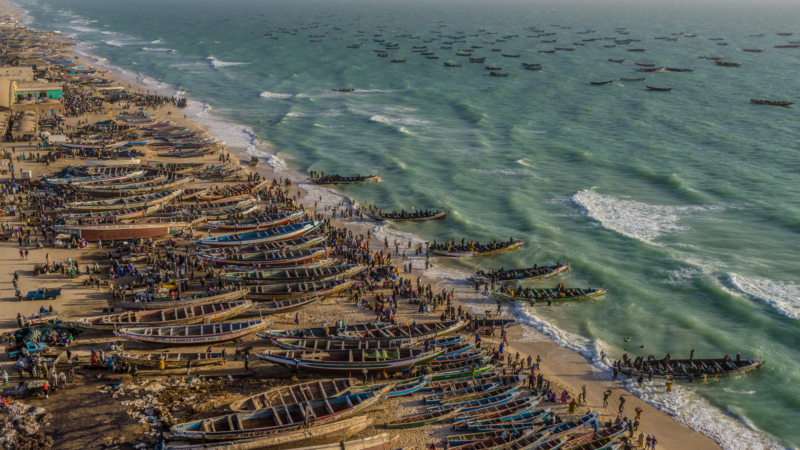PHOTOS: A drone’s eye view of ‘foodscapes,’ from cattle to soybeans to shrimp
We usually encounter our food roughly at eye level: stacked on shelves in the supermarket, displayed on stands at outdoor markets, beckoning at the Thanksgiving table.
Acclaimed photographer George Steinmetz wanted to bring a different perspective to our daily bread, protein and produce. As he looks at the way food makes its way to feed a constantly growing human population, he works mainly with drones for a bird’s eye view. In his “foodscapes,” human, boats and machines all play a role.

Steinmetz is a pioneer of photographing from above. Before the advent of drones, he’d soar (and sometimes crash) in low-flying paragliders — which he compared to “flying lawn chairs.” As drones improved in quality, he made the switch in 2015.
For this project, Steinmetz and his low-flying drones documented food production across six continents, 36 countries, 27 U.S. states and five oceans.
The images are featured is his latest book, Feed the Planet: A Photographic Journey to the World’s Food. The accompanying text, by journalist Joel K. Bourne, Jr., documents the food-print these practices leave on our environment.

In a photograph from Nouakchott, Mauritania, hundreds of small fishing boats, called piroques, arrive in the port of this African nation, some afloat on the waves, some coming in with their catch. But beyond the picturesque is a backstory of concerns about the supply of fish. Local fish are moving farther north due to rising sea temperatures, leading to competition and conflicts with fishermen in neighboring Senegal.
“The United Nations Food and Agriculture Organization, which compiles global fisheries data, reported in 2019 that more than a third of fish stocks were overfished, while 57% were at maximum sustainable harvest,” Bourne writes.

The boats harken back to ancient times, but much of food production today is ultra-modern. Over the course of his travels, Steinmetz was struck “by the existence of all these tremendously super-industrialized globalized production sites,” he says, as well as “the dominant trend everywhere toward mechanization.” Both are on view in his photo of the soybean harvest at Fazenda Piratini, Bahia, Brazil, where rows of crops vanish into the distance as futuristic-looking machines work the land.

Looking down from above, he says, a camera can capture the ecosystems of the world and the changes they are seeing — like “a map that is happening right before you.” That’s evident in the photo (above) showing the paths of deforestation carved by illegal clearcutting for cattle farms, logging and gold mining in Pará State, near Itaituba in Brazil.

Super-sized agricultural companies and production sites are on view throughout the book. The Wrangler Feedyard in Tulia, Texas, houses about 50,000 head of cattle; when added to the other nine feedlots owned by Amarillo-based Cactus Feeders the total is 500,000.
After further fattening up (they arrive at about 750 pounds each) for several months, the cattle are sent to slaughterhouses.

Steinmetz also learned that a slaughterhouse has its own special procedures to get the right parts of the animal to the right market. At a large pig slaughterhouse in Brazil, Steinmetz recounts, each carcass could provide “something like ten different individual parts to each of ten different countries where they could get the best prices. The noses sold well in Nigeria. There was a good market for the feet in China.”

As for the market for shrimp, the At Avanti Frozen Foods in Yerravaram, Andhra Pradesh, India, exports about 75% of its frozen shrimp to the U.S.; Costco is a major customer.

In spite of so much mechanization and expansion, however, Steinmetz notes the continuing existence of traditional agricultural practices in Amish country in Pennsylvania; in Emilio-Romagna, Italy, where Parmigiano Reggiano is still produced as it was in the Middle Ages; and in the small Polish village of Suloszowa, Poland, where families maintain the small strips of farmland allotted to each household in the 16th-century.

Meanwhile, in the East Arsi region of Ethiopia, barley, known as the country’s “king of crops” had been farmed for 5,000 years, the government is trying to distribute higher-yielding varieties of the grain throughout the country, where in 2023 civil conflict and drought contributed to leaving 20 million people in a state of food insecurity.

In the midst of such needs, community kitchens that serve free meals are welcome. One such site is the Sri Harmandir Sahib, or Golden Temple, in Amritsar in Punjab State, India, where 100,000 people receive hot vegetarian meals daily.
In selecting the photos for his book, Steinmetz says, “I tried to strike a balance between wonder and worry. Wonder at how much we’ve been able to improve productivity,” and at the same time, getting across the message that “we want to try to protect what little wild places we have left in our planet.”
Diane Cole writes for many publications, including The Wall Street Journal and The Washington Post. She is the author of the memoir After Great Pain: A New Life Emerges. Her website is DianeJoyceCole.com.
Israel detains a Gaza hospital director, Palestinian medical officials say
Gaza's Health Ministry said Dr. Hussam Abu Safiya, director of Kamal Adwan Hospital, was arrested by Israeli forces along with dozens of other staff and taken to an interrogation center.
How to fight ageism in the world around you — and in yourself
Discrimination based on someone's age is so ingrained in society that most of us don't notice it. Yet it affects us all and fighting it not only helps make a better society, it also helps us live longer, healthier lives.
Severe weather could disrupt holiday travel, with tornadoes forecast in the South
Severe thunderstorms and an outbreak of tornadoes could disrupt holiday travel Saturday. More than 3,000 flights were delayed.
Instagram reel roundup: School for dads, COVID conundrum, skateboarders in skirts
The most popular Instagram reels from our Goats and Soda team: Bolivia's bold women skateboarders, ponytail-making lessons, a perplexing COVID situation, fog harvesting.
Putin apologizes to Azerbaijani leader for ‘tragic incident’ involving crashed plane
The Kremlin said air defense systems were firing near Grozny due to a Ukrainian drone strike as the Azerbaijani airliner attempted to land, but stopped short of saying one of these hit the plane.
Opinion: Prayers are messages for our own hearts
Hanukkah began on Christmas this year. A reflection on celebrating both holidays in a multi-faith family.







